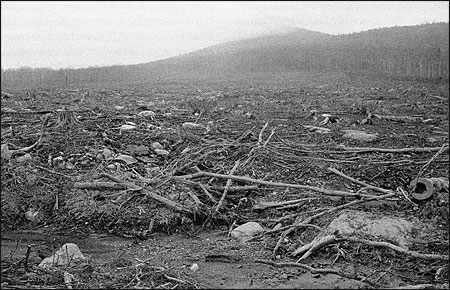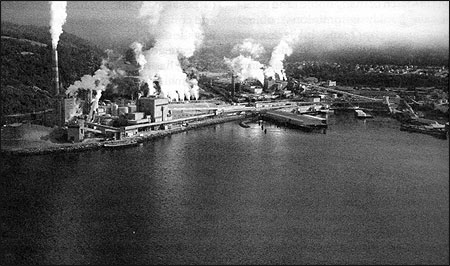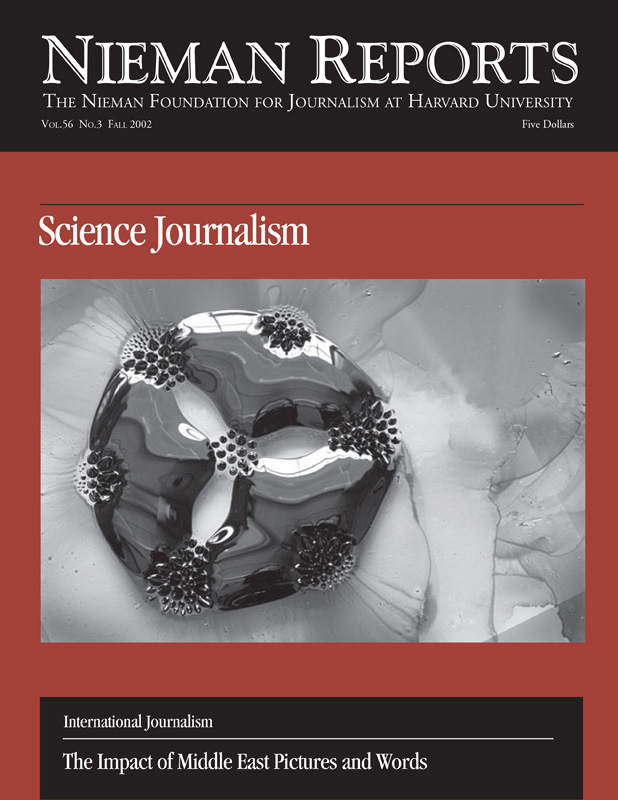
“Near Moosehead Lake”—a view of a fresh clearcut in Maine, 1996. Photo by © Barbara Shamblin.
One part of a great conundrum of our time is that, psychologically, the most efficient way to convey literate intellectual property from one mind to another is through the silent reading of words and graphics printed on paper. The printed word virtually defines our society. The first intellectual skill we acquire as children, after learning to talk, is the ability to read. We read to learn, to entertain ourselves, to enlighten our understanding of society and of the universe, to protect our rights and freedoms, and to keep abreast of our times and the discoveries of our contemporaries.
It is no accident, then, that print has become a dominant medium in the transfer of complex information despite the warnings of Marshall McLuhan about the pervasive negative influence on print of radio and television and despite the digital revolutions of the last century.
Paralleling the growth in literacy, and in search of many noble (and occasionally frankly ignominious) objectives, more paper and ink are consumed industrially today than at any time in history. And that consumption shows no signs of abating.
The paradox is that the production of the printed word is arguably the most egregiously wasteful and obsolete industrial process of our age. No other activity in a contemporary industrial society comes as close to the enormous devastation of natural resources, to the accumulation and propagation of redundant information, or to the mountains of discarded rubbish to be disposed of, than the publishing industries.
In the half a century that I have been variously employed in publishing, the depredations of the environment and the problems associated with garbage disposal have mounted almost daily and continue to do so. Environmentalists should take a look in their search for scapegoats at the contribution publishing has made to the accumulation of human detritus and see what is required in the process of transferring intellectual property, via print, on paper.
Paper today, of course, starts with trees. Some plastics are currently used and so are a few other natural fibers like cotton, sisal and hemp. But trees are overwhelmingly the base raw material of the printed word. To satisfy the current pulp, paper and lumber demand from Canadian forests we annually cut or clear more than one million hectares of forest growth—approxi-mately 4,000 square miles. The area implicated is equivalent to clearing a parcel of land the boundaries of which stretch from Buffalo, New York, 30 miles north to Niagara Falls, 70 miles east along the shore of Lake Ontario to Rochester, and 85 miles west back to Buffalo twice each year. In Ontario, Canada, we cut or clear an area equivalent to 46 kilometers square (29 miles square) each year. And, in provincial pulp and paper production, we are led only by Quebec in quantity produced.
The trees involved that are “harvested” are at least 25 years old and frequently—as in British Columbia, which is third in provincial output— much older. The cut timber is ground to wood chips for shipment, or is transported directly, to pulp and paper mills to be converted into pulp that is either shipped as such or made directly into paper.
The process of making industrial web paper is at once awesome, miraculous and a prodigious engineering accomplishment. It takes place on industrial papermaking machines—these are about 300 meters in length and 60 meters wide—and consume immense amounts of natural water that is discharged back into the environment, after the papermaking process, as a largely sulfurous effluent. Engineering has not yet provided an adequate solution to disposing of the noxious effluent that the process produces. That is yet to come.
In 1999, Canadian shipments of pulp and paper amounted to some 31 million metric tons, with sales of $22 billion (Canadian). Last year, Canadian production of newsprint, pulp, packaging and printing and writing papers all increased about 10 percent over the previous year. That growth continues.
The domestic destination for the enormous stream of resulting paper is—for the most part—the publishing industry: that is to say newspaper, magazine and book publishers, with a significant amount going to the direct marketing and advertising industries. And here the vexing conflict begins between the most efficient way of transferring complex knowledge and the spectacular waste and hazards of the manufacturing process needed to do so. Printing requires volatile inks. The solvents for these inks are as noxious to the atmospheric environment as the effluent from pulp and paper manufacture is to streams and rivers. Still, efforts to “scrub” the evaporating solvents before they are released into the air are being made and, to some extent, enforced.
It is estimated that 47.7 percent of Canada’s 10,820,000 households take a daily newspaper—the most visible daily result of papermaking and printing. Some take more than one. The average weight of newsprint delivered to the doors of households in metropolitan areas and across Canada each week is about 2.43 kilograms (5.35 lbs.). Thus to supply all subscribers who take a local newspaper and those who take a metropolitan or national daily in addition, newspaper publishers must distribute some 12,500 metric tons (13,800 tons) of newsprint to Canadian households around the country each week.
The implications of this on the efficiency of transmitting a plethora of information thus produced to the recipient are environmentally catastrophic.
The Globe and Mail edition of a Thursday, for example, customarily contains 120 pages—the equivalent of three-and-a-half 240-page paperback books—much more on a Saturday. That’s about 210,000 words awaiting a reader. A good reader, taking in about 300 words a minute, would need 11 hours and 30 minutes to read the content of all 120 pages.
The Globe and Mail is just a convenient example and not particularly singled out. A similar case could be made with The Toronto Star, the National Post, The Vancouver Sun, or any large metropolitan daily in Canada.
Statistics Canada reports that, on average, only 34 percent of the adult population would spend one hour and 18 minutes a day reading books, magazines and newspapers. Women spend slightly more time reading than men do. The majority of Canadian adults 15 years of age and over spend less than 24 minutes in daily reading—compared to two hours and 12 minutes at the TV set or VCR. (These statistics don’t take into account the reading time devoted to education, incidentally. Nine percent of adults 15 and over spend an average of six hours a day in educational pursuits, so there is more reading done there.)
But the point is made. Large amounts, up to 90 percent of printed pages in newspapers, go unread. No one reads the entire stock tables, for example. Nor every word of the report on business. Nor all the classified ads. Not many women, statistics show, read much in the sports section.
Special advertising supplements and inserts are largely ignored by both sexes, as are weekly giveaways, fliers and the newsprint advertising that reaches most metropolitan and urban households today. Households generally throw out their newspapers each day or each week. So the process of making data available, that began by cutting down a tree, pulping the log, making the paper, printing the material, distributing to the household, ends unceremoniously in the recycling bin. The majority of the content of Canada’s 106 daily newspapers is thus entirely redundant and unread.
How about magazines? For the 1,552 Canadian magazine publications reported to Statistics Canada there is a slightly different, better, although not very encouraging story. Magazine readership—particularly by those who have a subscription—is more assiduous than that of newspapers. Better than half of a magazine’s content is read by about 65 percent of its readership for most paid circulation consumer magazines. For the controlled circulation periodicals—and this includes much of Canada’s business press—the story is very different. Few of these publications are more than glanced at.
Subscribers keep paid circulation consumer magazines around the household—normally until the next issue arrives. Some, like Reader’s Digest, National Geographic, Canadian Geographic, Canadian Living, and other such magazines, are kept in the house for several months, sometimes for years—though, in that time, they are seldom if ever referred to.
Newspapers and magazines have multiple readers—anything from 2.6 to 3.7 readers per copy, and these publications are picked up and read on more than one occasion. So-called newsstand magazine and newspaper copies—in reality, single-copy sales mostly at supermarkets—tell a different story. To keep sales racks full, for every single magazine copy sold, one is thrown away. Canadian Living, for example, with a single-copy sale of 160,000 copies a month, must throw out the equivalent numbers unopened and unread. Enormous quantities of glossy magazine publications are similarly thrown out, unopened and unread, in North America every year. The covers are simply torn off by the retailers and sent back to the distributors for a credit on their portion of the cover price. The insides are dumped for recycling.
With paperback and hardcover books, the fate of the pages is not so different. For every popular paperback book that is sold, at least one—and sometimes as many as three—is thrown away; shelf life in a retail store for a popular paperback is about six weeks. About eight times a year, the paperback stock is cleaned out and replaced with new titles. For some popular authors, with a print run in the millions, hundreds of thousands of copies are junked every four to six weeks.
A purchased copy of a hardcover or paperback book—except for those purchased by libraries—is normally read once before it is put on a bookshelf to be warehoused for the lifetime of the owner. It is seldom referred to again. Up to 50 percent of all hardcover titles found in independent and big-box bookstores—fiction and nonfiction—are returned to publishers each year either to be remaindered—that is sold at or below production cost—or to be warehoused prior to destruction. And 15 to 20 percent of the content of landfill sites in North America before the advent of recycling consisted of dumped paper.
Today, recycling is alleviating part of the paper wastage and the decimation of forests. But the slogan that a product or publication contains recycled paper bears close scrutiny. Recycling of paper in the printing industry usually means the recycling of pre-consumer waste. This waste is simply make-ready paper used in setting up papermaking machines and printing presses before the production or the publishing print-run starts. Recycled printed paper, because of the progressive reduction in the length of the cellulose fibers caused by the recycling process, diminishes in grade with each recycling from fine papers, newsprint and other white printable stock, to corrugated board and packaging material. And the effluent from recycling—bleaching agents and the like—is sometimes worse than the reducing effluents from the papermaking process in the first place.
This all adds up to a gloomy picture of the publishing industry—one that is ignored, overlooked and pushed aside in our considerations of those segments that are classed as a sensitive cultural industry in Canada in need of protection from the predatory forces of foreign ownership and competition.
Is relief in sight? Most newspaper news content is now available online. Technology and digital data processing hold out some hope. For example, printing-on-demand is a looming potential book publishing innovation. One merely needs to retain digitized text and illustrations electronically and load onto a digital printer to provide an immediate copy when needed at the point of sale.
Downloading digitized text onto reusable, sensitized, plastic pages is another innovation under experiment. In this ingenious process it is possible to download up to 20 pages of readable text from the computers of experimental publishers onto a paper substitute that has all the appearances of a small book. When that has been read, it can be electronically deleted, ready to download the next 20 pages—on an endlessly reusable publishing page.
Cost is the current obstacle to the widespread use of that technology. There are doubtless other potential advances in the offing but, as always, economic factors will determine the rate and extent of their implementation. At the moment, there is an abundant supply of trees. Insect infestation and forest fires destroy more forest than is cut and cleared annually for pulp and paper in Canada.
The pulp and paper, publishing and printing industries are worth nearly $100 billion (Canadian) annually to the Canadian economy and provide employment for better than 500,000 people. Forest industries are by far the largest net export component of Canada’s international trade and are its most widely dispersed industrial employer, supporting 350 or more communities across Canada.
And, when all is said and done, the printed word—despite the formidable inefficiency, waste and redundancy of content it carries in all its manifestations—is still the most profoundly effective means of transferring intellectual property from one mind to another. And there’s the dilemma.
This mill on the Powell River in British Columbia produces about 227,000 metric tons of newsprint each year—a little over a quarter of the total newsprint production of its parent company, NorskeCanada. Photo courtesy of © PhotographyTips.com.
Ralph Hancox, a 1966 Nieman Fellow, is professional fellow and visiting professor emeritus at The Canadian Centre for Studies in Publishing, Simon Fraser University, Vancouver, British Columbia.



